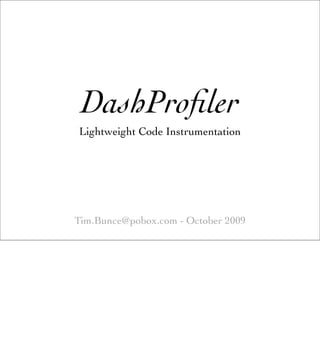
Dash Profiler 200910
- 1. DashProfiler Lightweight Code Instrumentation Tim.Bunce@pobox.com - October 2009
- 2. A Problem A web application ~100K lines of code Using many external services If response time goes up... what’s causing it? Continuous monitoring in production Must have very low CPU and I/O cost Minimal code changes
- 3. A Typical Approach package MyNetIO; sub send_request { my ($hostname, $request) = @_ ...send to $hostname... } How much time was spent sending the request?
- 4. A Typical Approach package MyNetIO; use Time::Hires qw(time); sub send_request { my ($hostname, $request) = @_ my $start = time(); ...send to $hostname... $durations->{MyNetIO}{$hostname} = time() - $start; } • Doesn’t record count so can’t produce averages. • Two lines of code. Worse if multiple return statements. • Doesn’t record time if function exits via an exception. Still need to write code to flush
- 5. A Solution: DashProfiler Simple Flexible Lightweight
- 6. DashProfiler • Can group samples into granular time units • Can measure exclusive time in a period • Can flush to disk at intervals • Just needs one line of code per sample
- 7. DashProfiler Internals Built on DBI::Profile, part of the DBI Aggregates measurements into a data tree Two-level tree by default: $root->{ $key1 }->{ $key2 }->[ ...leaf node... ] $root->{ ‘MyNetIO’ }->{ $hostname }->[ ...leaf node... ]
- 8. DashProfiler Data Each leaf node in the tree is a reference to an array: $root->{ $key1 }->{ $key2 } = [ 106, # 0: count of samples at this node 0.0312958955764771, # 1: total duration 0.000490069389343262, # 2: first duration 0.000176072120666504, # 3: shortest duration 0.00140702724456787, # 4: longest duration 1023115819.83019, # 5: time of first sample 1023115819.86576, # 6: time of last sample ] First sample populates all Later samples always update 0, 1, and 6 and may update 3 or 4
- 9. DashProfiler By-Time Optional extra time level in the data tree $time = int(time() / $granularity) * $granularity; $root->{ $time }->{ ‘MyNetIO’ }->{ $hostname }->[ ... ] So a new sub-tree is grown each granularity seconds
- 10. DashProfiler Config use DashProfiler; DashProfiler->add_profile( foo => { } ); DashProfiler->add_profile( foo => { granularity => 10, flush_interval => 600, flush_hook => sub { ... }, sample_class => ‘DashProfiler::Sample’, dbi_profile_class => ‘DBI::Profile’, period_exclusive => ..., period_summary => ..., ... }); Create named profiles Lots of features
- 11. Without DashProfiler package MyNetIO; use Time::Hires qw(time); sub send_request { my ($hostname, $request) = @_ my $start = time(); ...send to $hostname... $durations->{MyNetIO}{$hostname} = time() - $start; }
- 12. Without DashProfiler package MyNetIO; use DashProfiler::Import foo_profiler => [ ‘MyNetIO’ ]; sub send_request { my ($hostname, $request) = @_ my $sample = foo_profiler( $hostname ); ...send to $hostname... } - imports a pre-curried profiler code ref DashProfiler::Import - Profilers return bless object containing timestamp - Object destruction triggers accumulation of sample
- 13. With DashProfiler Name of profile created with add_profile() Value to use for ‘key1’ package MyNetIO; use DashProfiler::Import foo_profiler => [ ‘MyNetIO’ ]; sub send_request { Value to use for ‘key2’ my ($hostname, $request) = @_ my $sample = foo_profiler( $hostname ); ...send to $hostname... } Duration is measured when $sample goes out of scope
- 14. With DashProfiler package MyNetIO; use DashProfiler::Import foo_profiler => [ ‘MyNetIO’ ]; sub send_request { my ($hostname, $request) = @_ my $sample = foo_profiler( $hostname ) if foo_profiler_enabled(); ...send to $hostname... Automatically imported compile-time constant } reduces cost to zero if profile is disabled
- 15. DashProfiler Flush Data is written to STDERR on exit, by default Regular flushing is enabled by specifying a flush_interval The dbi_profile_class handles the flush. Choices include: DBI::Profile DBI::ProfileData DBI::ProfileData::Apache DashProfiler->add_profile( foo => { ..., flush_interval => 600, dbi_profile_class => ‘DBI::ProfileData’, flush_hook => sub { ... }, ... });
- 16. DashProfiler Periods • Group samples into periods - e.g. http request to response - start_sample_period() and end_sample_period() - counted, to enable averages and totals per period - can output period counts instead of sample counts • Measure ‘exclusive’ time - time from period start to end that’s not been accounted for by other samples - enabled via period_exclusive option
- 17. Example Data Average response times over 24 hours DashProfiler doesn’t generate graphs itself, but the data can be used to create graphs like these
- 18. Example Data Worst case response times over 24 hours
- 19. DashProfiler Perspectives • Each DashProfiler can have multiple DBI Profile objects attached • Samples accumulate in all attached profiles • Each profile can have a different Path • giving different ‘perspectives’ or level of detail - key1 + key2 - key1 + country + browser type - key2 + browser type - ... etc.
- 20. DashProfiler Per-Period • Optional extra ‘per-period’ DBI profile • Enabled via period_summary option • Automatically attached and reset by start_sample_period() • Gives current totals for this period • Great for ‘debug footers’ on web page showing how much time was spent generating this page
- 21. DashProfiler Cost Time cost of taking a sample: 0.000021s - Time to create sample object, destroy it, accumulate the counts - In hot code can be 0.000015s - (Timings made on a 2GHz MacBook Pro Intel Core Duo) - (Could be made much faster by porting sampler class to C)
- 22. Questions? Tim.Bunce@pobox.com @timbunce on twitter http://blog.timbunce.org